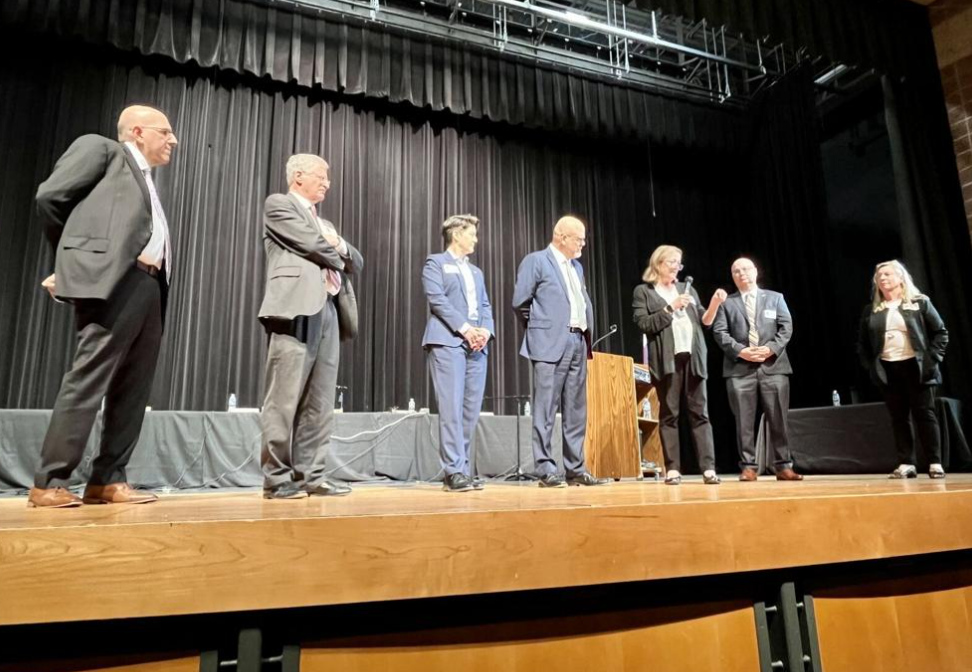Garden of the Gods picture frame fight is just latest uproar in Colorado

The big blue frame that drew so much ire in Colorado Springs before it was removed from Garden of the Gods has many historic cousins.
From Bulgarian-born artist Christo’s canceled plan to drape the Arkansas River with miles of shimmering fabric to the Army’s decade-long debacle to expand the Piñon Canyon Maneuver Site, it’s a lesson Coloradans have been eager to teach:
Mess with Colorado’s treasures, even in a small way, and you’re liable to be smashed by public opinion.
Public relations expert Janet Stevens said there’s no mystery behind the uproar. It’s a factor of Colorado’s civic pride.
“It is the treasure that we have here,” she said. “It is the thing we can boast about.”
The latest lesson – the hulking 12-foot-tall frame – was erected last week at Garden of the Gods to attract tourists. After a few days of blowback, the city removed it Monday.
“We have received some very thoughtful citizen comments asking for its relocation and we thank those citizens who took the time for constructive communication,” city spokeswoman Jaime Fabos said in a Monday email. “In recognition of public sentiment, we are in the process of removing the frame from its current location.”
In no particular order of past lessons, here’s a walk down memory lane.
A war for a generalIf you think the public had a strong reaction to the park picture frame, take a look at the downtown statue of city founder Brig. Gen. William Jackson Palmer.
A quarter of a century ago, downtown boosters plotted to move the statue to a nearby park, saying its location in the middle of Nevada Avenue at Platte Avenue posed a traffic hazard.
Former Mayor Mary Lou Makepeace recalls the turmoil that rose around the general and his trusty horse.
“It never advanced to an actual proposal, but people talked about making it a roundabout,” Makepeace said Monday.
The downtown boosters had a point: The Civil War hero has been battling traffic for nearly a century, and the base of his towering statue has the fender and bumper scars to prove it.
But the general had a powerful set of allies who decried the move.
“You’ll notice he’s in the same place,” Makepeace said.
The Army’s lost battleWhile the Army hero won that fight, the Army lost a long campaign to expand the 235,000-acre Piñon Canyon Maneuver Site east of Trinidad.
Starting in 2005, the service wanted to buy cattle ranches around the sparsely-populated region to add more than 100,000 acres for training.
But it hadn’t planned on the gigantic reaction that grew from one of Colorado’s tiniest towns, Kim, population 65.
Lon Robertson, who owns the town’s Kim Outpost general store, led the charge against the Army. He said it proved an easy sell, even in cities such as Pueblo and Denver.
The Army fought for years but lost to the cattle ranchers.
“It gets to the bigger picture of why Coloradans don’t want the government to mess with things,” Robertson said. “You respect the surroundings, and you want others to show some respect. Otherwise we end up losing it.”
A mountainous uproarIf you want to see public outcry at top volume, try messing with Pikes Peak.
Protests echoed from the mountain’s summit to the chambers of City Hall in 1983 after a local philanthropist donated 18 powerful lights that were placed on the peak to light America’s Mountain at night.
“Police and fire departments couldn’t keep up with all the calls that first night when those down below were concerned the Summit House was on fire,” the Gazette’s Linda Navarro wrote at the time. “There were folks who complained they couldn’t sleep because it was all too bright. Down the lights came.”
The lights have left a bright mark in Colorado Springs.
Resident Mark Hemman remembered the illuminating debacle in an email to The Gazette.
“Some time ago, a bunch of lights were installed on the building on the top of Pikes Peak,” he wrote. “It was a good idea, but due to the public’s opinion, they were removed. Fast forward to now, a big blue frame was installed in the Garden of the Gods. It was a good idea, but due to the public’s opinion it was removed. Maybe it could be relocated to the mayor’s back yard as a reminder of why it’s important to ask first.”
Fabric plan foldsYou can ask the public, but when it comes to efforts to “enhance” Colorado’s natural beauty, you might not like the answer.
Internationally-acclaimed artist Christo came to Colorado in 1992 with a bold plan to temporarily cover a 42-mile section of the Arkansas River with silvery fabric. The $50 million project got federal approval but never won over neighbors.
A group formed Rags Over the Arkansas River and sued, tying up the artist in court for five years.
Woodland Park public relations expert Mike Perini said it’s part of a common theme.
“People don’t necessarily like change. And if you’re going to make a change, you have to communicate it in an effective way that builds public support,” Perini said.
Getting a group to oppose an issue has never been easier, Perini said. An angry mob is just a tweet away.
“People can build momentum through social media,” he said.
Christo never could overcome the momentum of energized locals. He folded the fabric project earlier this year.
The case for changeSo how do you get anything done in a state where locals are set in their ways?
Makepeace said the first part is easy. Just ask.
People are proud of the Pikes Peak region and expect to have input when changes are pondered, she said.
“You know what they get upset about? They need to be asked,” Makepeace said of the blue frame. “When people feel like someone is making a decision for them, that’s when they get upset.”
Stevens said officials also need to understand how deeply locals care about their surroundings.
Colorado Springs is a city of newcomers who have adopted the place as their hometown, she said.
“I came here for this environment, so don’t screw it up,” she said of local sentiment. “Don’t mess with what I came here for.”
Officials also should understand that old-timers want to make sure that the future doesn’t go to war with the past, Robertson said.
“Everybody takes pride in their history and heritage,” he said. “We’ve all been assigned as guardians for it.”
Perini said making a change also means building a coalition of supporters. That means gathering opinions and moving slowly.
“You need to really build support for whatever you are going to do and communicate it,” he said. “For whatever reason, people tend to want to have their voices heard.”
And if you’re looking at changes to a community icon such as Garden of the Gods, you better be ready for trouble.
“There’s mom, apple pie and Garden of the Gods,” Perini said. “You have to think that through.”














